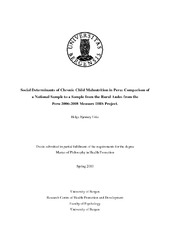| dc.contributor.author | Urke, Helga Bjørnøy | |
| dc.date.accessioned | 2011-07-28T07:31:30Z | |
| dc.date.available | 2011-07-28T07:31:30Z | |
| dc.date.issued | 2010 | eng |
| dc.identifier.uri | https://hdl.handle.net/1956/4855 | |
| dc.description.abstract | Introduction: This study explored social determinants of chronic child malnutrition on national level and in very poor ruralities in the Andean region in Peru. Methods: Two samples were studied, a national sample, (n = 1426) and a rural subsample, (n = 171). The samples consisted of women age 15-49 and their firstborn children 3-60 months of age. Data were provided by the Demographic and Health Survey ENDES Continua 2004-2006 (DHS 2004-2006). The variable for child malnutrition was composed by anthropometric measures of height and age, and 2 standard deviations below the WHO growth standard indicated chronic malnutrition or stunting. The influence of a range of variables on child stunting were tested through bivariate and logistic regression analyses performed in SPSS. Results: For the national sample, the traditional socioeconomic indicators were found to be significantly associated with child stunting. Especially wealth, education and occupation were strong predictors even after controlling for possible confounding variables like age, altitude, and ethnicity. For the rural subsample, none of the classical socioeconomic measures were statistically significantly related to child stunting, indicating that other factors play a greater role in reducing child malnutrition. Altitude was a strong predictor for both samples. Discussion. The diverging results comparing national and rural sample indicate that the widely used measures of income/wealth, education and occupation are not successful at explaining differences in health in very poor ruralities. Rather structural, natural, and cultural structures not addressed in the survey might play more important roles in producing differences in child growth. The results from this study support findings from other studies on social determinants of health in remote and extremely poor areas. Conclusion: The differing results between the national and rural sample show that one must be careful in generalising findings concerning determinants of health from national to regional levels. | en_US |
| dc.description.abstract | Introduksjon: Denne studien undersøkte sosiale determinantar for kronisk underernæring i born nasjonalt og i svært fattige område i Andesregionen i Peru. Metode: Studiet brukte to utval, eit nasjonalt (n = 1426), og eit underutval sett saman av fem av dei statistisk sett fattigaste statane i dei rurale Andesområda i Peru (n = 171). Utvala bestod av kvinner i alderen 15-49 år og det fyrstefødde barnet deira i alderen 3-60 månader. Studiet nytta data frå den nasjonale undersøkinga ENDES Continua 2004-2006 innsamla av Demographic and Health Survey (DHS 2004-2006). Variabelen for kronisk underernæring var sett saman av antropometriske mål for høgde og alder, og 2 standardavvik under Verdas Helseorganisasjon sine vekststandardar indikerte kronisk underernæring. Effekten av ei rekkje uavhengige variablar på underernæring vart testa i bivariate og logistiske regresjonsanalysar i SPSS. Resultat: Logistisk regresjonsanalysar i det nasjonale utvalet viste at dei tradisjonelle sosioøkonomiske indikatorane var statistisk signifikante når testa mot underernæring. Både økonomi, yrke og utdanning var sterke prediktorar sjølv når underliggjande variablar som alder, høgde over havet, og etnisitet vart kontrollert for. I det rurale underutvalet vart det ikkje funne statistisk signifikans for dei klassiske sosioøkonomiske faktorane. Dette indikerer at i dette området er det andre faktorar som har større betyding for reduseringa av kronisk underernæring i born. Høgde over havet var ein sterk prediktor for begge utval. Diskusjon. Dei avvikande resultata som vart funne når ein samanliknar dei to utvala indikerer at dei mykje brukte måla inntekt/formue, utdanning og yrke ikkje er like meiningsfulle i forsøket på å forklare skilnader i underernæring i svært fattige område som på nasjonalt nivå. Strukturelle, geografiske, og kulturelle forhold som ikkje er teke opp i undersøkinga kan spele større roller i veksten til born i området undersøkt her. Denne studia støttar opp under andre funn som har undersøkt effekten av sosiale determinantar for helse i svært fattige og rurale området i verda. Konklusjon: Dei ulike resultat for det nasjonale og rurale utvalet viser at ein må vere varsam med å generalisere funn angåande determinantar for helse frå nasjonalt til regionalt nivå. | no_NO |
| dc.language.iso | eng | eng |
| dc.publisher | The University of Bergen | eng |
| dc.subject | Child stunting | eng |
| dc.subject | Poor ruralities | eng |
| dc.subject | Social determinants of health | eng |
| dc.subject | Socioeconomic status | eng |
| dc.title | Social Determinants of Chronic Child Malnutrition in Peru: Comparison of a National Sample to a Sample from the Rural Andes from the Peru 2006-2008 Measure DHS Project. | eng |
| dc.type | Master thesis | |
| dc.rights.holder | Copyright the author. All rights reserved | |
| dc.rights.holder | The author | eng |
| dc.description.degree | Master of Philosophy in Health Promotion | |
| dc.description.localcode | PSHE390T | |
| dc.description.localcode | MPHEPRO | |
| dc.subject.nus | 769909 | eng |
| dc.subject.nsi | VDP::Medical disciplines: 700::Health sciences: 800::Nutrition: 811 | eng |
| dc.subject.nsi | VDP::Medical disciplines: 700::Health sciences: 800 | eng |
| fs.subjectcode | PSHE390T | |
